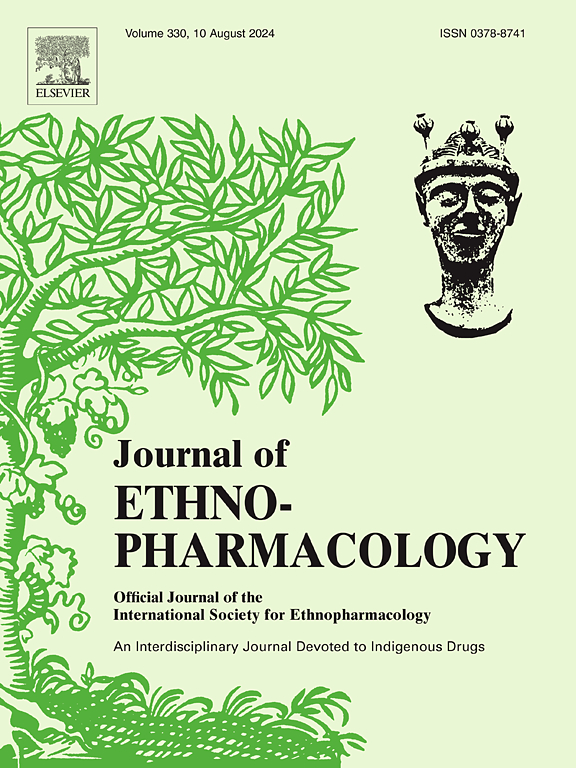巴西核桃树根皮治疗疼痛和炎症的传统知识和药理证据
IF 4.8
2区 医学
Q1 CHEMISTRY, MEDICINAL
引用次数: 0
摘要
民族药理学相关性巴西aryocar brasiliense (pequi)在巴西用于烹饪和药用目的。虽然其果实和油已被广泛研究,但其根皮传统上被用作抗炎药,但其药理特性仍未被探索。目的研究巴西木根皮的化学成分、抗氧化活性、抗炎和抗过敏作用以及潜在毒性,以验证其传统用途。材料与方法采用冷浸渍法(1 ~ 9天)制备三聚氰胺水提物,模拟传统用法并评价化合物稳定性。用LC-DAD-MS分析其化学成分,用Folin-Ciocalteu法分析其酚类和单宁,用DPPH法分析其抗氧化活性。对秀丽隐杆线虫进行毒性评价。采用角叉菜胶诱导小鼠足部水肿和醋酸诱导小鼠扭体,对其抗炎和抗过敏作用进行了实验。结果浸渍8 d后,浸提液化学性质稳定,平均酚类含量为6.1%,单宁含量为5.0%。具有抗氧化活性(IC50 = 16.15±0.77 μg/mL)。LC-DAD-MS鉴定了没食子酰单宁、鞣花单宁、可水解单宁和三萜皂苷。体内实验证实了抗炎和抗过敏作用,对秀丽隐杆线虫无毒性。结论证实了巴西木根皮治疗疼痛和炎症的传统用途,支持其作为具有民族药理学意义的生物活性物质来源的潜力。本文章由计算机程序翻译,如有差异,请以英文原文为准。

Traditional knowledge and pharmacological evidence of pequi (Caryocar brasiliense) root bark for pain and inflammation
Ethnopharmacological relevance
Caryocar brasiliense (pequi) is used in Brazil for culinary and medicinal purposes. While its fruit and oil have been extensively studied, the root bark is traditionally used as an anti-inflammatory, but its pharmacological properties remain unexplored.
Aim of the study
This study investigates the chemical composition, antioxidant activity, anti-inflammatory and anti-hyperalgesic effects, and potential toxicity of C. brasiliense root bark to validate its traditional use.
Materials and methods
An aqueous extract was prepared via cold maceration (1–9 days) to simulate traditional use and assess compound stability. Chemical composition was analyzed by LC-DAD-MS, phenolics and tannins by the Folin-Ciocalteu method, and antioxidant activity via DPPH assay. Toxicity was evaluated in Caenorhabditis elegans. The anti-inflammatory and anti-hyperalgesic effects were tested in mice using carrageenan-induced paw edema and acetic acid-induced writhing.
Results
Throughout the 8-day maceration period, the extract maintained chemical stability, with an average phenolic content of 6.1 % and tannins at 5.0 %. It exhibited antioxidant activity (IC50 = 16.15 ± 0.77 μg/mL). LC-DAD-MS identified galloyl tannins, ellagitannins, hydrolyzable tannins, and triterpenic saponins. In vivo assays confirmed anti-inflammatory and anti-hyperalgesic effects, with no toxicity in C. elegans.
Conclusion
The results validate the traditional use of C. brasiliense root bark for pain and inflammation, supporting its potential as a source of bioactive compounds with ethnopharmacological significance.
求助全文
通过发布文献求助,成功后即可免费获取论文全文。
去求助
来源期刊

Journal of ethnopharmacology
医学-全科医学与补充医学
CiteScore
10.30
自引率
5.60%
发文量
967
审稿时长
77 days
期刊介绍:
The Journal of Ethnopharmacology is dedicated to the exchange of information and understandings about people''s use of plants, fungi, animals, microorganisms and minerals and their biological and pharmacological effects based on the principles established through international conventions. Early people confronted with illness and disease, discovered a wealth of useful therapeutic agents in the plant and animal kingdoms. The empirical knowledge of these medicinal substances and their toxic potential was passed on by oral tradition and sometimes recorded in herbals and other texts on materia medica. Many valuable drugs of today (e.g., atropine, ephedrine, tubocurarine, digoxin, reserpine) came into use through the study of indigenous remedies. Chemists continue to use plant-derived drugs (e.g., morphine, taxol, physostigmine, quinidine, emetine) as prototypes in their attempts to develop more effective and less toxic medicinals.
 求助内容:
求助内容: 应助结果提醒方式:
应助结果提醒方式:


